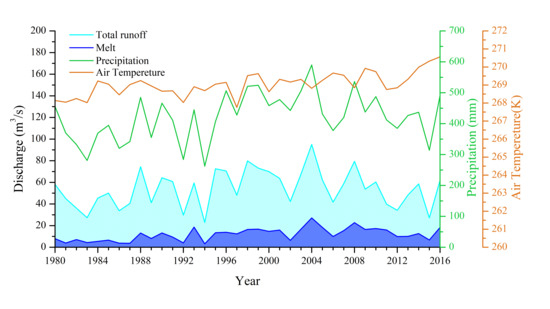Precipitation Dominates Long-Term Water Storage Changes in Nam Co Lake (Tibetan Plateau) Accompanied by Intensified Cryosphere Melts Revealed by a Basin-Wide Hydrological Modelling
Abstract
:1. Introduction
2. Datasets and Study Area
2.1. Study Area
2.2. Datasets
2.2.1. Spatial Data
2.2.2. Remote Sensing Data
2.2.3. Meteorological Forcing Data
2.2.4. In-Situ Observations
3. Method
3.1. WEB-DHM Model
3.2. Lake Surface Evaporation
3.2.1. Evaporation Calculation
3.2.2. Frozen Period Estimation
3.3. Evaluation Criteria
4. Results
4.1. Precipitation Correction
- CMFD_corr_May = 0.73 * CMFD_May
- CMFD_corr_Jun = 0.54 * CMFD_Jun
- CMFD_corr_Jul = 0.65 * CMFD_Jul
- CMFD_corr_Aug = 1.15 * CMFD_Aug
- CMFD_corr_Sep = 1.35 * CMFD_Sep
- CMFD_corr_Oct = 2.46 * CMFD_Oct
4.2. Evaluation of WEB-DHM
4.2.1. Evaluation with Discharge
4.2.2. Basin-Scale Evaluation with MODIS LST
4.2.3. Basin-Scale Evaluation with Snow Depth
4.3. Variations of Major Water Balance Components
4.4. Long-Term Changes of Nam Co Lake Water Storage
5. Discussion
5.1. Uncertainty of Lake Surface Evaporation
5.2. Uncertainty of Total Lake Inflows
5.3. The Contributions of Precipitation, Snow and Glacier Melt to the Discharge
5.4. Impact of Climate Change
6. Conclusions
Author Contributions
Funding
Acknowledgments
Conflicts of Interest
References
- Molden, D.; Shrestha, A.B.; Nepal, S.; Immerzeel, W. Downstream Implications of Climate Change in the Himalayas. In Water Resources Development and Management; Springer Science and Business Media LLC: Berlin, Germany, 2015; pp. 65–82. [Google Scholar]
- Immerzeel, W.; Van Beek, L.P.H.; Bierkens, M.F.P. Climate Change Will Affect the Asian Water Towers. Science 2010, 328, 1382–1385. [Google Scholar] [CrossRef] [PubMed]
- Zhang, H. Remote Sensing Based Hydrological Dynamic Analysis of Lake in Tibetan Plateau and its Response to Climate Change. Master’s Thesis, Liaocheng University, Liaocheng, China, 2018. (In Chinese). [Google Scholar]
- Song, C.; Huang, B.; Ke, L.; Richards, K.S. Seasonal and abrupt changes in the water level of closed lakes on the Tibetan Plateau and implications for climate impacts. J. Hydrol. 2014, 514, 131–144. [Google Scholar] [CrossRef]
- Yang, K.; Ye, B.; Zhou, D.; Wu, B.; Foken, T.; Qin, J.; Zhou, Z. Response of hydrological cycle to recent climate changes in the Tibetan Plateau. Clim. Chang. 2011, 109, 517–534. [Google Scholar] [CrossRef]
- Yao, T.; Pu, J.; Lu, A.; Wang, Y.; Yu, W. Recent Glacial Retreat and Its Impact on Hydrological Processes on the Tibetan Plateau, China, and Surrounding Regions. Arct. Antarct. Alp. Res. 2007, 39, 642–650. [Google Scholar] [CrossRef] [Green Version]
- Song, C.; Huang, B.; Ke, L. Modeling and analysis of lake water storage changes on the Tibetan Plateau using multi-mission satellite data. Remote Sens. Environ. 2013, 135, 25–35. [Google Scholar] [CrossRef]
- Lei, Y.; Yang, K.; Wang, B.; Sheng, Y.; Bird, B.W.; Zhang, G.; Tian, L. Response of inland lake dynamics over the Tibetan Plateau to climate change. Clim. Chang. 2014, 125, 281–290. [Google Scholar] [CrossRef]
- Song, C.; Huang, B.; Ke, L. Heterogeneous change patterns of water level for inland lakes in High Mountain Asia derived from multi-mission satellite altimetry. Hydrol. Process. 2014, 29, 2769–2781. [Google Scholar] [CrossRef]
- Phan, V.; Lindenbergh, R.C.; Menenti, M. ICESat derived elevation changes of Tibetan lakes between 2003 and 2009. Int. J. Appl. Earth Obs. Geoinf. 2012, 17, 12–22. [Google Scholar] [CrossRef]
- Zhang, G.; Xie, H.; Yao, T.; Kang, S. Water balance estimates of ten greatest lakes in China using ICESat and Landsat data. Chin. Sci. Bull. 2013, 58, 3815–3829. [Google Scholar] [CrossRef] [Green Version]
- Zhang, G. Changes in lakes on the Tibetan Plateau observed from satellite data and their responses to climate variations. Adv. Earth Sci. 2018, 37, 214–223. (In Chinese) [Google Scholar]
- Wu, Y.; Zhu, L. The response of lake-glacier variations to climate change in Nam Co Catchment, central Tibetan Plateau, during 1970–2000. J. Geogr. Sci. 2008, 18, 177–189. [Google Scholar] [CrossRef]
- Kropacek, J.; Braun, A.; Kang, S.; Feng, C.; Ye, Q.; Hochschild, V. Analysis of lake level changes in Nam Co in central Tibet utilizing synergistic satellite altimetry and optical imagery. Int. J. Appl. Earth Obs. Geoinf. 2012, 17, 3–11. [Google Scholar] [CrossRef]
- Liu, J.; Kang, S.; Gong, T.; Lu, A. Growth of a high-elevation large inland lake, associated with climate change and permafrost degradation in Tibet. Hydrol. Earth Syst. Sci. 2010, 14, 481–489. [Google Scholar] [CrossRef] [Green Version]
- Lei, Y.; Yao, T.; Bird, B.W.; Yang, K.; Zhai, J.; Sheng, Y. Coherent lake growth on the central Tibetan Plateau since the 1970s: Characterization and attribution. J. Hydrol. 2013, 483, 61–67. [Google Scholar] [CrossRef]
- Zhang, B.; Wu, Y.; Zhu, L.; Wang, J.; Li, J.; Chen, N. Estimation and trend detection of water storage at Nam Co Lake, central Tibetan Plateau. J. Hydrol. 2011, 405, 161–170. [Google Scholar] [CrossRef]
- Zhu, L.; Xie, M.; Wu, Y. Quantitative analysis of lake area variations and the influence factors from 1971 tom 2004 in the Nam Co basin of the Tibetan Plateau. Chin. Sci. Bull. 2010, 55, 1294–1303. (In Chinese) [Google Scholar] [CrossRef]
- Ma, Y.; Yi, C.; Wu, J. Lake Surface Expansion of Nam Co during 19702009: Evidence of Satellite Remote Sensing and Cause Analysis. J. Glaciol. Geocryol. 2012, 34, 81–88. (In Chinese) [Google Scholar]
- Zhou, S.; Kang, S.; Chen, F.; Joswiak, D.R. Water balance observations reveal significant subsurface water seepage from Lake Nam Co, south-central Tibetan Plateau. J. Hydrol. 2013, 491, 89–99. [Google Scholar] [CrossRef]
- Du, Y.; Huang, Z.; Xie, M.; Farooq, A.; Chen, C. Temporal Variations in the Quantity of Groundwater Flow in Nam Co Lake. Water 2018, 10, 941. [Google Scholar] [CrossRef] [Green Version]
- Wu, H.; Wang, N.; Jiang, X.; Guo, Z. Variations in water level and glacier mass balance in Nam Co lake, Nyainqentanglha range, Tibetan Plateau, based on ICESat data for 2003-09. Ann. Glaciol. 2014, 55, 239–247. [Google Scholar] [CrossRef] [Green Version]
- Gao, T.; Kang, S.; Krause, P.; Cuo, L.; Nepal, S. A test of J2000 model in a glacierized catchment in the central Tibetan Plateau. Environ. Earth Sci. 2011, 65, 1651–1659. [Google Scholar] [CrossRef]
- Krause, P.; Biskop, S.; Helmschrot, J.; Flügel, W.-A.; Kang, S.; Gao, T. Hydrological system analysis and modelling of the Nam Co basin in Tibet. Adv. Geosci. 2010, 27, 29–36. [Google Scholar] [CrossRef] [Green Version]
- Adnan, M.; Kang, S.; Zhang, G.; Saifullah, M.; Anjum, M.N.; Ali, A.F. Simulation and Analysis of the Water Balance of the Nam Co Lake Using SWAT Model. Water 2019, 11, 1383. [Google Scholar] [CrossRef] [Green Version]
- Tanguang, G.; Shichang, K.; Cuo, L.; Tingjun, Z.; Guoshuai, Z.; Yulan, Z.; Sillanpää, M. Simulation and analysis of glacier runoff and mass balance in the Nam Co basin, southern Tibetan Plateau. J. Glaciol. 2015, 61, 447–460. [Google Scholar] [CrossRef]
- Gao, T.; Kang, S.; Zhang, T.; Zhou, S.; Cuo, L.; Sillanpää, M.; Zhang, Y. Summer hydrological characteristics in glacier and non-glacier catchments in the Nam Co Basin, southern Tibetan Plateau. Environ. Earth Sci. 2015, 74, 2019–2028. [Google Scholar] [CrossRef]
- Zhang, G.; Kang, S.; Cuo, L.; Qu, B. Modeling hydrological process in a glacier basin on the central Tibetan Plateau with a distributed hydrology soil vegetation model. J. Geophys. Res. Atmos. 2016, 121, 9521–9539. [Google Scholar] [CrossRef] [Green Version]
- Wu, Y.; Zheng, H.; Zhang, B.; Chen, D.; Lei, L. Long-Term Changes of Lake Level and Water Budget in the Nam Co Lake Basin, Central Tibetan Plateau. J. Hydrometeorol. 2014, 15, 1312–1322. [Google Scholar] [CrossRef]
- Li, B.; Zhang, J.; Yu, Z.; Liang, Z.; Chen, L.; Acharya, K. Climate change driven water budget dynamics of a Tibetan inland lake. Glob. Planet. Chang. 2017, 150, 70–80. [Google Scholar] [CrossRef]
- Song, C.; Ye, Q.; Cheng, X. Shifts in water-level variation of Namco in the central Tibetan Plateau from ICESat and CryoSat-2 altimetry and station observations. Sci. Bull. 2015, 60, 1287–1297. [Google Scholar] [CrossRef] [Green Version]
- Wang, L.; Koike, T.; Yang, K.; Jackson, T.J.; Bindlish, R.; Yang, D. Development of a distributed biosphere hydrological model and its evaluation with the Southern Great Plains Experiments (SGP97 and SGP99). J. Geophys. Res. Space Phys. 2009, 114, 08107. [Google Scholar] [CrossRef] [Green Version]
- Wang, L.; Koike, T.; Yang, K.; Yeh, P.J.-F. Assessment of a distributed biosphere hydrological model against streamflow and MODIS land surface temperature in the upper Tone River Basin. J. Hydrol. 2009, 377, 21–34. [Google Scholar] [CrossRef]
- Wang, L.; Koike, T.; Yang, D.; Yang, K. Improving the hydrology of the Simple Biosphere Model 2 and its evaluation within the framework of a distributed hydrological model. Hydrol. Sci. J. 2009, 54, 989–1006. [Google Scholar] [CrossRef] [Green Version]
- Shrestha, M.; Wang, L.; Koike, T.; Xue, Y.; Hirabayashi, Y. Improving the snow physics of WEB-DHM and its point evaluation at the SnowMIP sites. Hydrol. Earth Syst. Sci. 2010, 14, 2577–2594. [Google Scholar] [CrossRef] [Green Version]
- Wang, L.; Zhou, J.; Qi, J.; Sun, L.; Yang, K.; Tian, L.; Lin, Y.; Liu, W.; Shrestha, M.; Xue, Y.; et al. Development of a land surface model with coupled snow and frozen soil physics. Water Resour. Res. 2017, 53, 5085–5103. [Google Scholar] [CrossRef]
- Qi, J.; Wang, L.; Zhou, J.; Song, L.; Li, X.; Zeng, T. Coupled Snow and Frozen Ground Physics Improves Cold Region Hydrological Simulations: An Evaluation at the upper Yangtze River Basin (Tibetan Plateau). J. Geophys. Res. Atmos. 2019, 124, 12985–13004. [Google Scholar] [CrossRef]
- Ma, N.; Szilagyi, J.; Niu, G.-Y.; Zhang, Y.; Zhang, T.; Wang, B.; Wu, Y. Evaporation variability of Nam Co Lake in the Tibetan Plateau and its role in recent rapid lake expansion. J. Hydrol. 2016, 537, 27–35. [Google Scholar] [CrossRef]
- Junfeng, W.; Shiyin, L.; Wanqin, G.; Xiaojun, Y.; Junli, X.; Weijia, B.; Zongli, J. Surface-area changes of glaciers in the Tibetan Plateau interior area since the 1970s using recent Landsat images and historical maps. Ann. Glaciol. 2014, 55, 213–222. [Google Scholar] [CrossRef] [Green Version]
- Bliss, A.; Hock, R.; Radic, V. Global response of glacier runoff to twenty-first century climate change. J. Geophys. Res. Earth Surf. 2014, 119, 717–730. [Google Scholar] [CrossRef]
- Rashid, I.; Majeed, U.; Aneaus, S.; Pelto, M. Linking the Recent Glacier Retreat and Depleting Streamflow Patterns with Land System Changes in Kashmir Himalaya, India. Water 2020, 12, 1168. [Google Scholar] [CrossRef] [Green Version]
- Ran, Y.; Li, X.; Lu, L. Evaluation of four remote sensing based land cover products over China. Int. J. Remote Sens. 2010, 31, 391–401. [Google Scholar] [CrossRef]
- Xiao, Z.; Liang, S.; Wang, J.; Chen, P.; Yin, X.; Zhang, L.; Song, J. Use of General Regression Neural Networks for Generating the GLASS Leaf Area Index Product From Time-Series MODIS Surface Reflectance. IEEE Trans. Geosci. Remote. Sens. 2013, 52, 209–223. [Google Scholar] [CrossRef]
- MOD11A1 MODIS/Terra Land Surface Temperature/Emissivity Daily L3 Global 1km SIN Grid V006. Available online: https://doi.org/10.5067/MODIS/MOD11A1.006 (accessed on 9 February 2020).
- Che, T.; Li, X.; Jin, R.; Armstrong, R.; Zhang, T. Snow depth derived from passive microwave remote-sensing data in China. Ann. Glaciol. 2008, 49, 145–154. [Google Scholar] [CrossRef] [Green Version]
- Li, X.; Long, D.; Huang, Q.; Han, P.; Zhao, F.; Wada, Y. High-temporal-resolution water level and storage change data sets for lakes on the Tibetan Plateau during 2000–2017 using multiple altimetric missions and Landsat-derived lake shoreline positions. Earth Syst. Sci. Data 2019, 11, 1603–1627. [Google Scholar] [CrossRef] [Green Version]
- Yang, K.; He, J.; Tang, W.; Qin, J.; Cheng, C.C. On downward shortwave and longwave radiations over high altitude regions: Observation and modeling in the Tibetan Plateau. Agric. For. Meteorol. 2010, 150, 38–46. [Google Scholar] [CrossRef]
- Chen, Y.; Yang, K.; He, J.; Qin, J.; Shi, J.; Du, J.; He, Q. Improving land surface temperature modeling for dry land of China. J. Geophys. Res. Space Phys. 2011, 116, 20104. [Google Scholar] [CrossRef]
- Rodell, M.; Houser, P.; Jambor, U.; Gottschalck, J.; Mitchell, K.; Meng, C.-J.; Arsenault, K.R.; Cosgrove, B.; Radakovich, J.; Bosilovich, M.; et al. The Global Land Data Assimilation System. Bull. Am. Meteorol. Soc. 2004, 85, 381–394. [Google Scholar] [CrossRef] [Green Version]
- Tropical Rainfall Measuring Mission. Available online: https://trmm.gsfc.nasa.gov/ (accessed on 9 February 2020).
- Gelaro, R.; Mccarty, W.; Suárez, M.J.; Todling, R.; Molod, A.; Takacs, L.; Randles, C.; Darmenov, A.; Bosilovich, M.G.; Reichle, R.H.; et al. The Modern-Era Retrospective Analysis for Research and Applications, Version 2 (MERRA-2). J. Clim. 2017, 30, 5419–5454. [Google Scholar] [CrossRef]
- Meteorological Observation Data from the Integrated Observation and Research Station of Multiple Spheres in Namco (2005–2016). Available online: https://data.tpdc.ac.cn/en/data/4deeb2b4-4fc1-4c7c-b0c6-6263a547d53f/ (accessed on 9 February 2020).
- Yang, D.; Herath, S.; Musiake, K. Comparison of different distributed hydrological models for characterization of catchment spatial variability. Hydrol. Process. 2000, 14, 403–416. [Google Scholar] [CrossRef]
- Yang, D.; Herath, S.; Musiake, K. A hillslope-based hydrological model using catchment area and width functions. Hydrol. Sci. J. 2002, 47, 49–65. [Google Scholar] [CrossRef]
- Sellers, P.; Tucker, C.; Collatz, G. A Revised Land Surface Parameterization (SiB2) for Atmospheric GCMS. Part I: Model Formulation. J. Clim. 1996, 9, 676–705. [Google Scholar] [CrossRef]
- Sellers, P.J.; Tucker, C.J.; Collatz, G.J.; Los, S.; Justice, C.O.; Dazlich, D.A.; Randall, D.A. A Revised Land Surface Parameterization (SiB2) for Atmospheric GCMS. Part II: The Generation of Global Fields of Terrestrial Biophysical Parameters from Satellite Data. J. Clim. 1996, 9, 706–737. [Google Scholar] [CrossRef] [Green Version]
- Wang, L.; Li, X.; Zhou, J. Hydrological modelling over the tibetan plateau: Current status and perspective. Adv. Earth Sci. 2014, 29, 674–682. (In Chinese) [Google Scholar]
- Penman, H.L. Natural evaporation from open water, bare soil and grass. Proc. R. Soc. London Ser. A Math. Phys. Sci. 1948, 193, 120–145. [Google Scholar] [CrossRef] [Green Version]
- McMahon, T.A.; Peel, M.C.; Lowe, L.; Srikanthan, R.; McVicar, T.R. Estimating actual, potential, reference crop and pan evaporation using standard meteorological data: A pragmatic synthesis. Hydrol. Earth Syst. Sci. 2013, 17, 1331–1363. [Google Scholar] [CrossRef] [Green Version]
- Yao, H. Long-Term Study of Lake Evaporation and Evaluation of Seven Estimation Methods: Results from Dickie Lake, South-Central Ontario, Canada. J. Water Resour. Prot. 2009, 1, 59–77. [Google Scholar] [CrossRef] [Green Version]
- Zhou, J.; Wang, L.; Zhang, Y. Exploring the water storage changes in the largest lake (Selin Co) over the Tibetan Plateau during 2003–2012 from a basin-wide hydrological modeling. Water Resour. Res. 2015, 51, 8060–8086. [Google Scholar] [CrossRef] [Green Version]
- Zhang, G.; Yao, T.; Xie, H.; Qin, J.; Ye, Q.; Dai, Y.; Guo, R. Estimating surface temperature changes of lakes in the Tibetan Plateau using MODIS LST data. J. Geophys. Res. Atmos. 2014, 119, 8552–8567. [Google Scholar] [CrossRef]
- Qu, B.; Kang, S.; Chen, F. Lake ice and its effect factors in the Nam Co Basin, Tibetan Plateau. Progress. Inquisitiones Mutat. Clim. 2012, 8, 327–333. (In Chinese) [Google Scholar]
- Gou, P.; Ye, Q.; Che, T.; Feng, Q.; Ding, B.; Lin, C.; Zong, J. Lake ice phenology of Nam Co, Central Tibetan Plateau, China, derived from multiple MODIS data products. J. Great Lakes Res. 2017, 43, 989–998. [Google Scholar] [CrossRef]
- Xue, B.-L.; Wang, L.; Yang, K.; Tian, L.; Qin, J.; Chen, Y.; Zhao, L.; Ma, Y.; Koike, T.; Hu, Z.; et al. Modeling the land surface water and energy cycles of a mesoscale watershed in the central Tibetan Plateau during summer with a distributed hydrological model. J. Geophys. Res. Atmos. 2013, 118, 8857–8868. [Google Scholar] [CrossRef]
- Lazhu; Yang, K.; Wang, J.; Lei, Y.; Chen, Y.; Zhu, L.; Ding, B.; Qin, J. Quantifying evaporation and its decadal change for Lake Nam Co, central Tibetan Plateau. J. Geophys. Res. Atmos. 2016, 121, 7578–7591. [Google Scholar] [CrossRef]
- Wang, B.; Ma, Y.; Wang, Y.; Su, Z.; Ma, W. Significant differences exist in lake-atmosphere interactions and the evaporation rates of high-elevation small and large lakes. J. Hydrol. 2019, 573, 220–234. [Google Scholar] [CrossRef]
- Duan, Z.; Bastiaanssen, W.G.M. Evaluation of three energy balance-based evaporation models for estimating monthly evaporation for five lakes using derived heat storage changes from a hysteresis model. Environ. Res. Lett. 2017, 12, 024005. [Google Scholar] [CrossRef] [Green Version]
- Gao, H.; He, X.; Ye, B.; Pu, J. Modeling the runoff and glacier mass balance in a small watershed on the Central Tibetan Plateau, China, from 1955 to 2008. Hydrol. Process. 2011, 26, 1593–1603. [Google Scholar] [CrossRef]
- Gao, H.; Ding, Y.; Zhao, Q.; Hrachowitz, M.; Savenije, H.H. The importance of aspect for modelling the hydrological response in a glacier catchment in Central Asia. Hydrol. Process. 2017, 31, 2842–2859. [Google Scholar] [CrossRef]
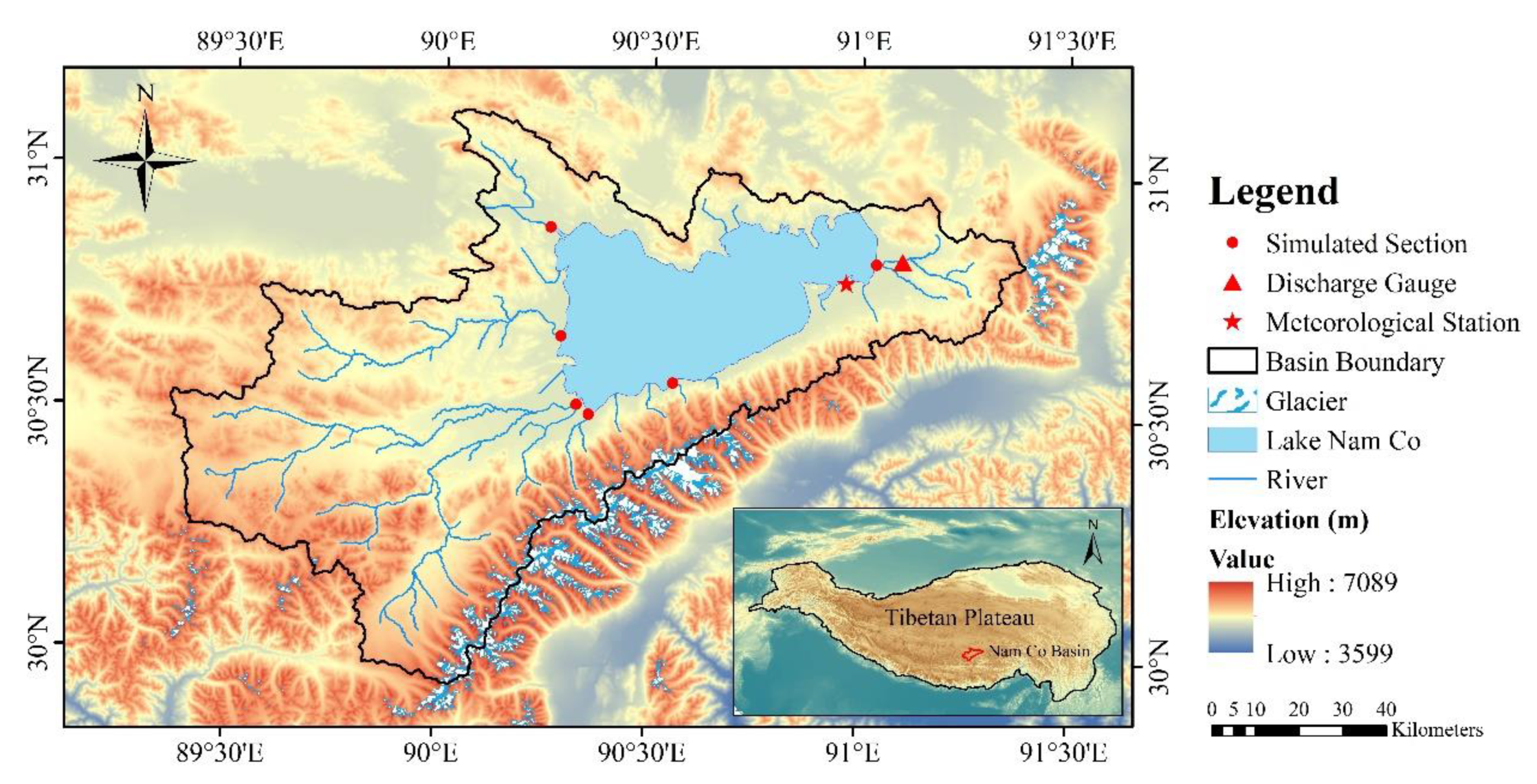


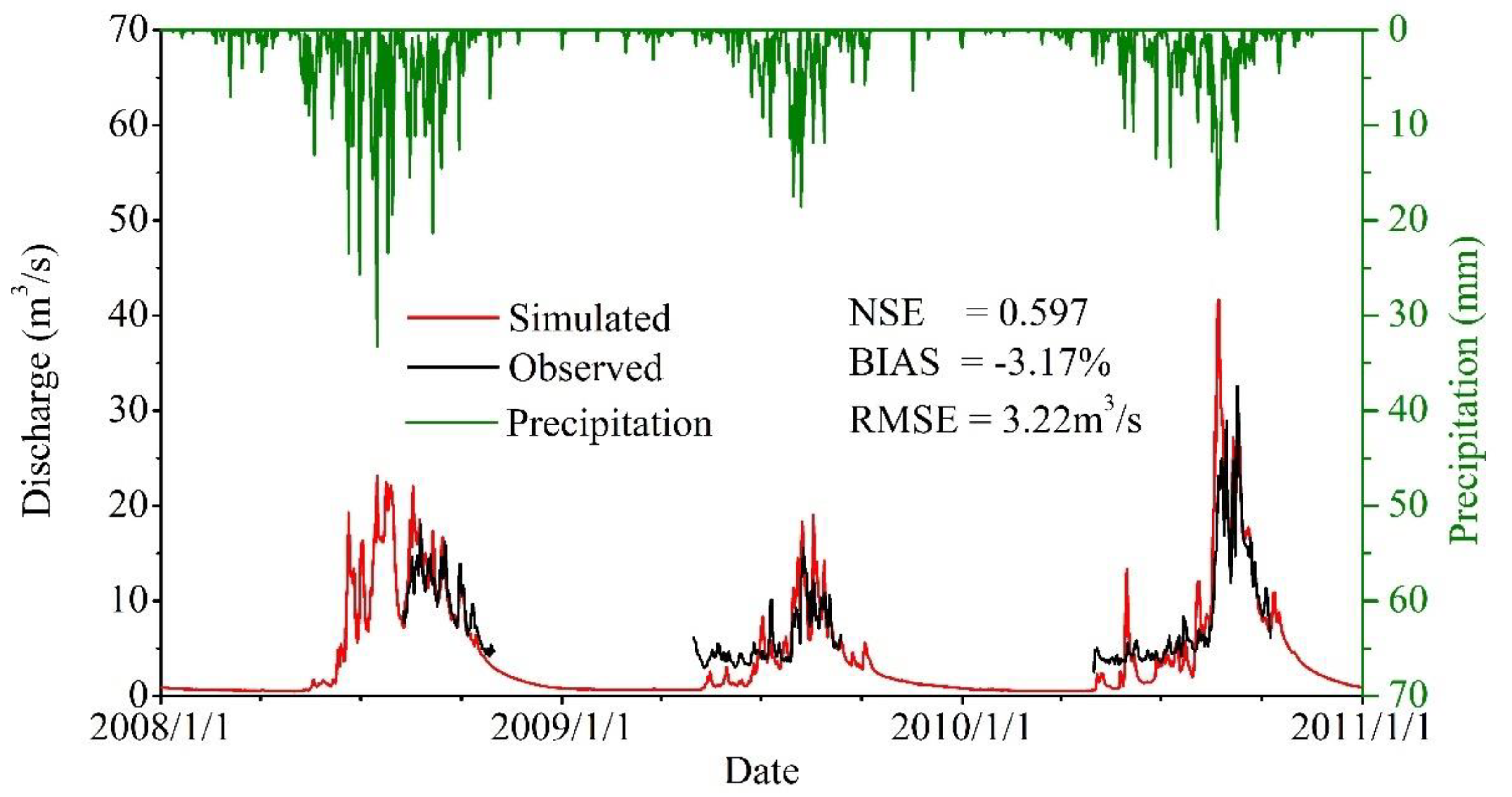
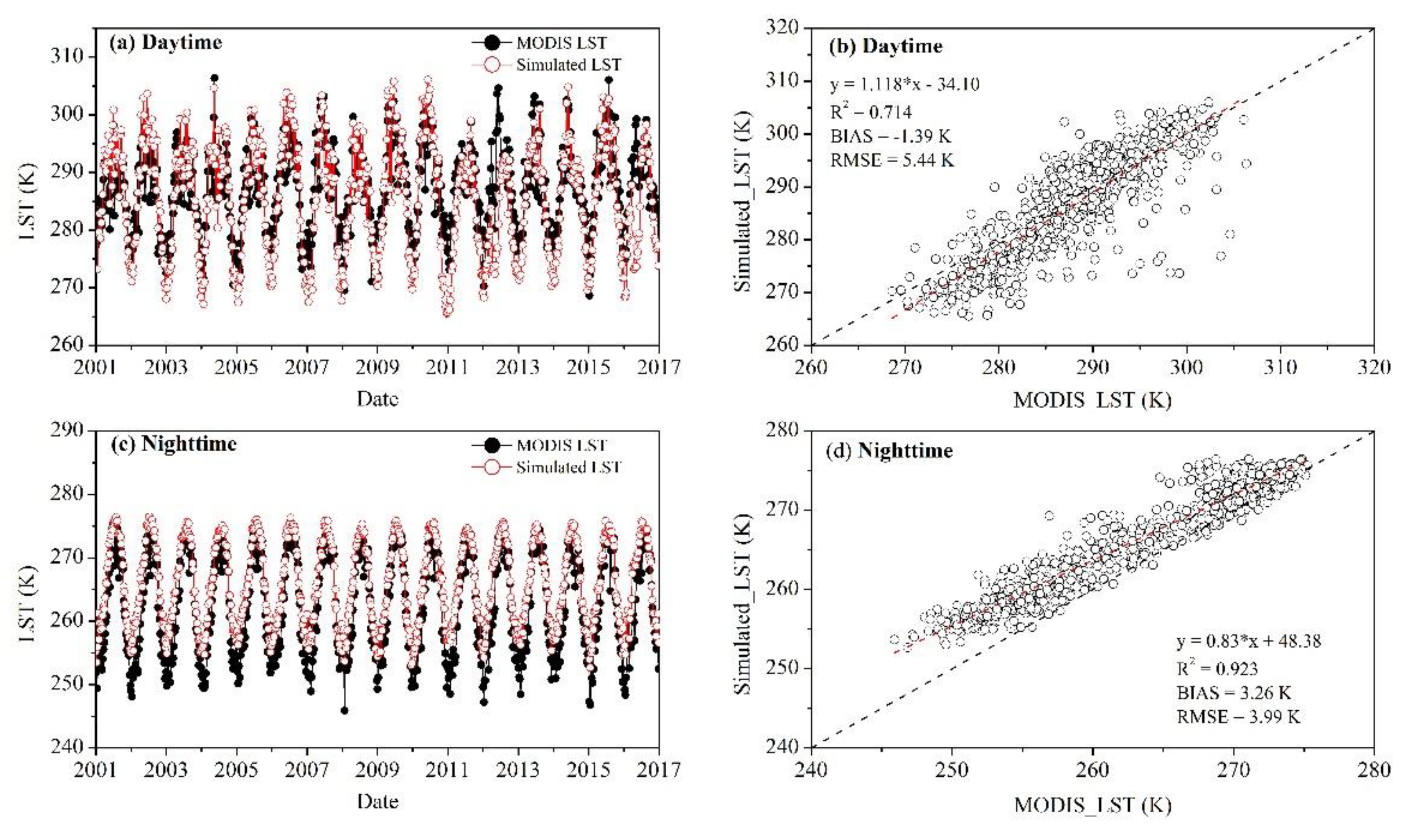
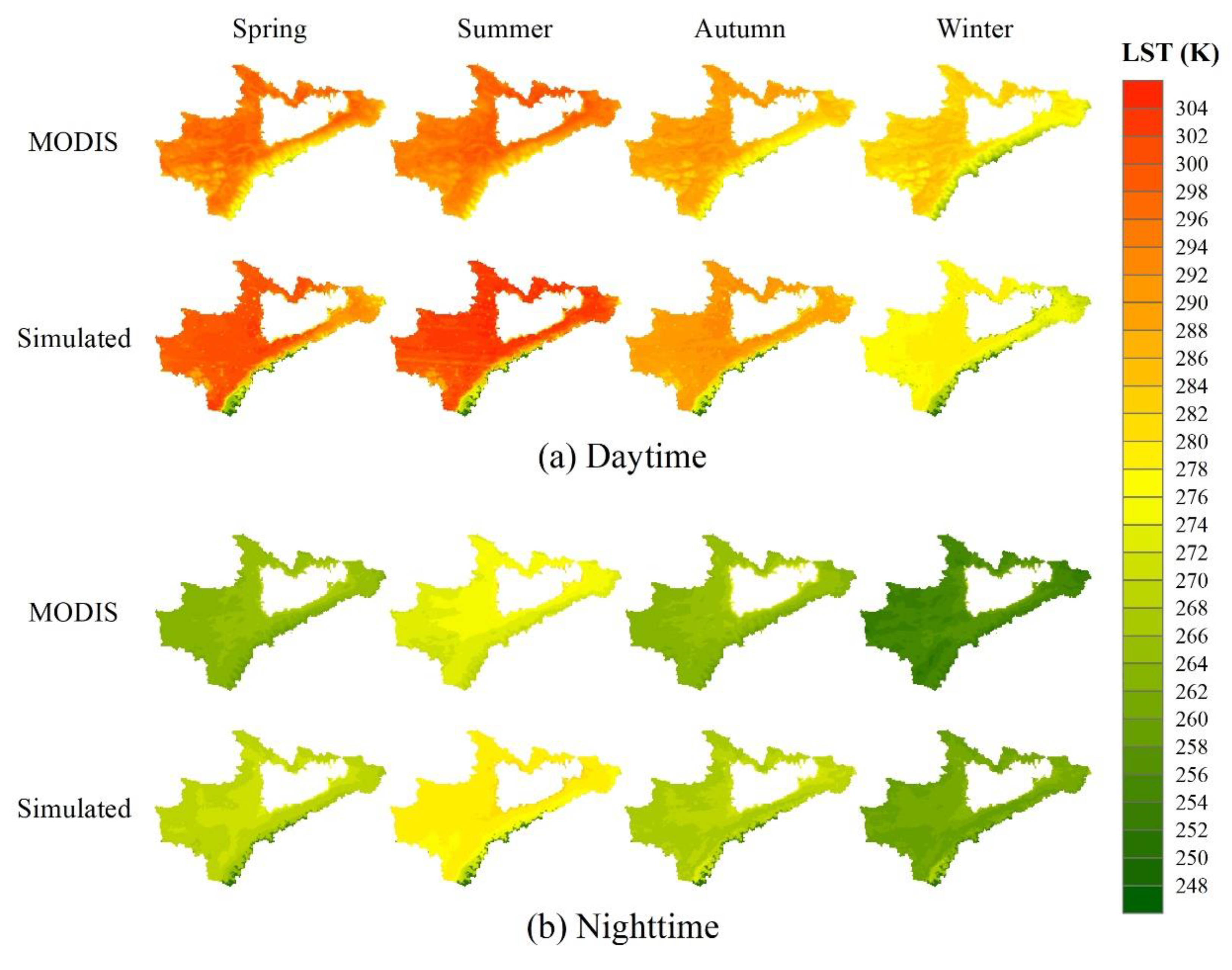

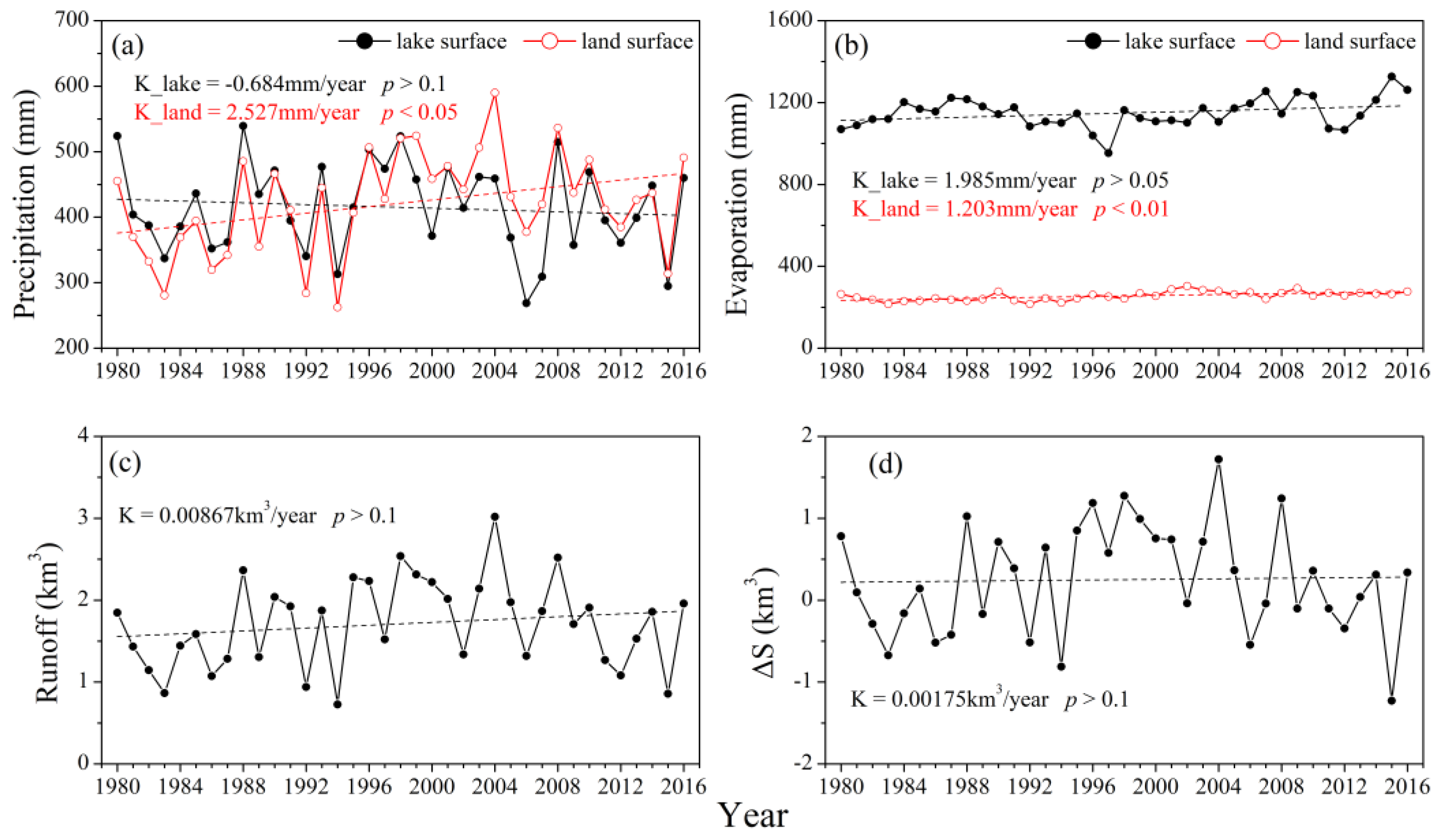
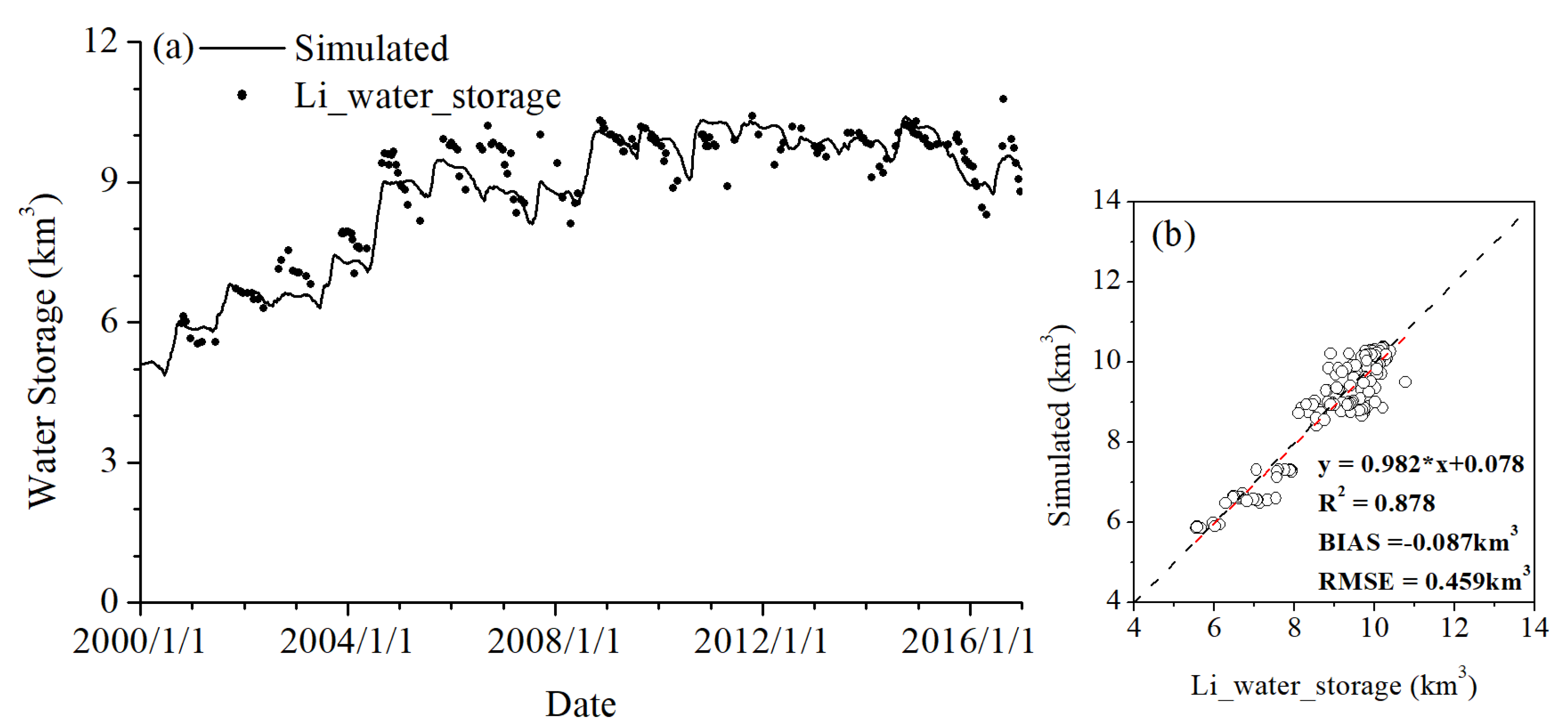
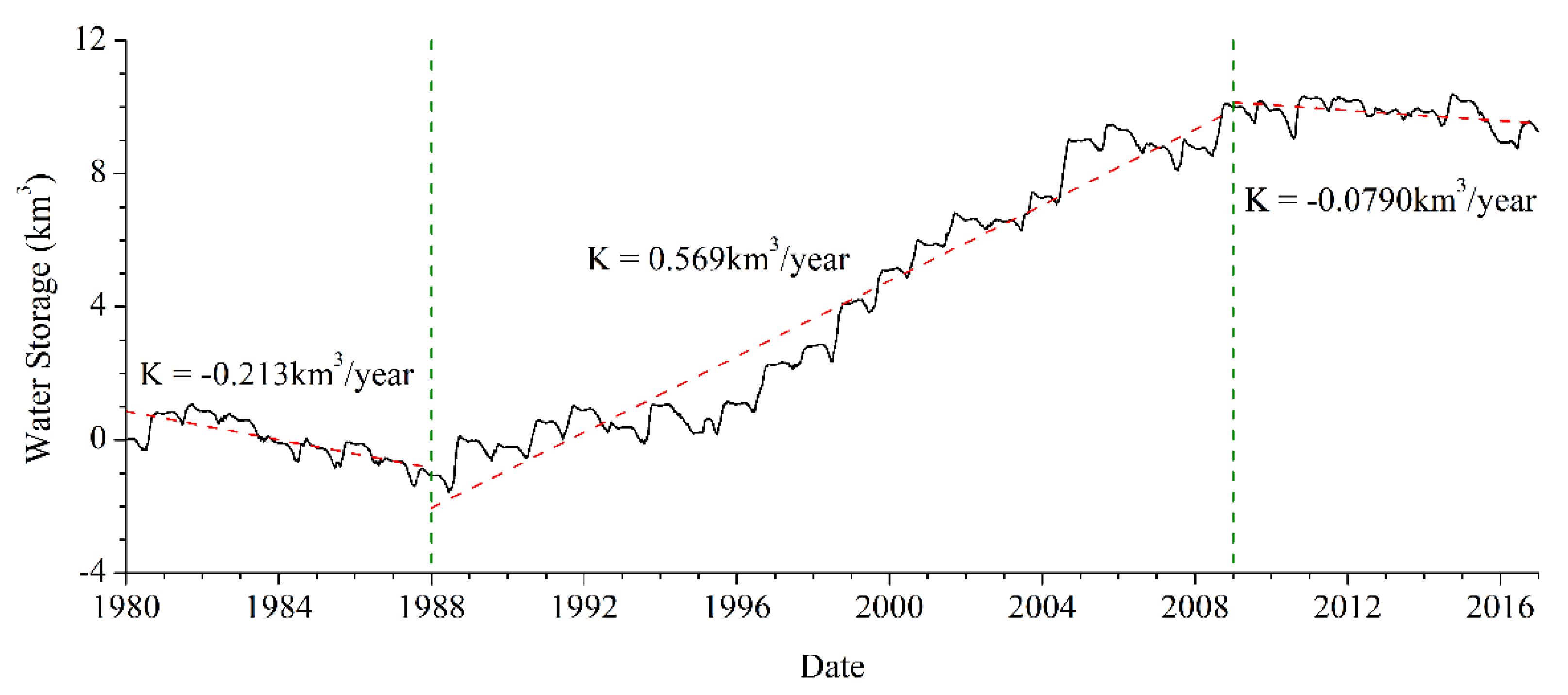

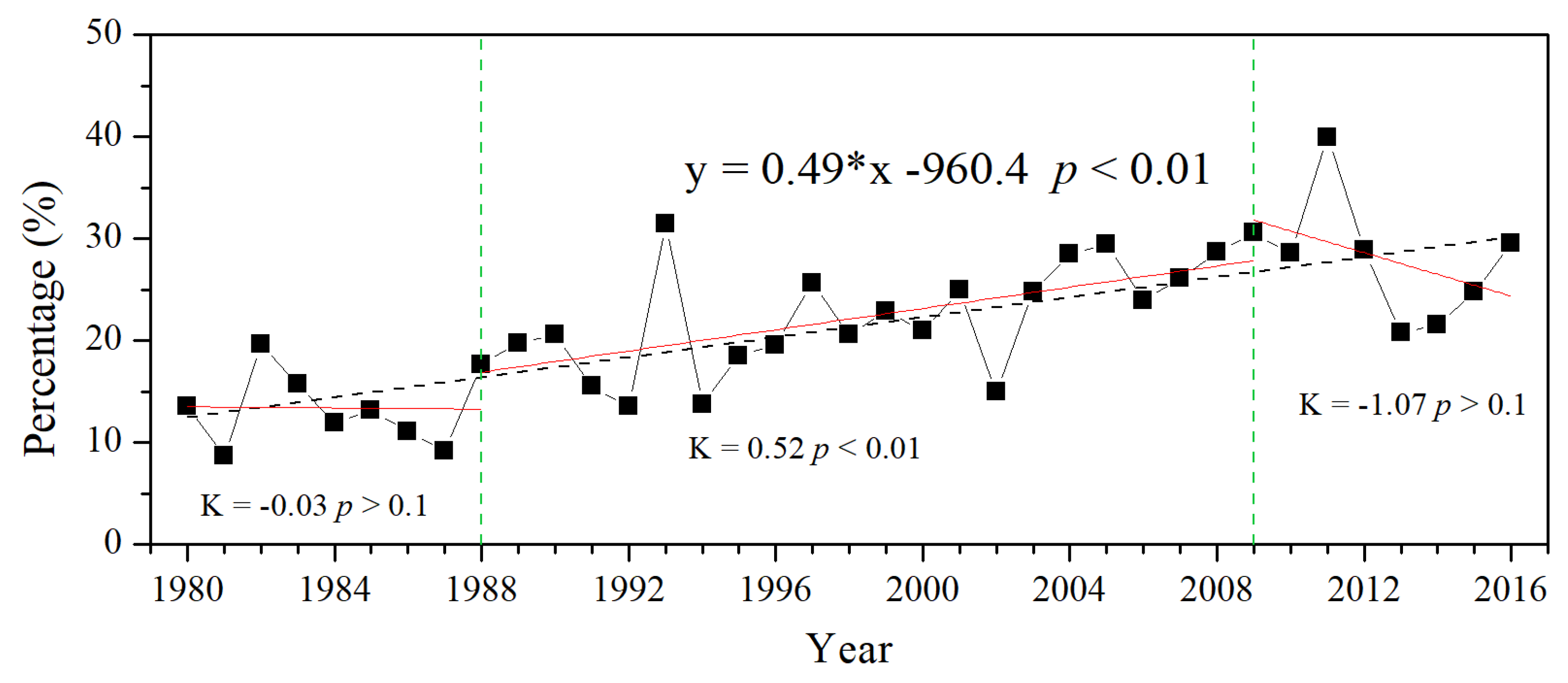
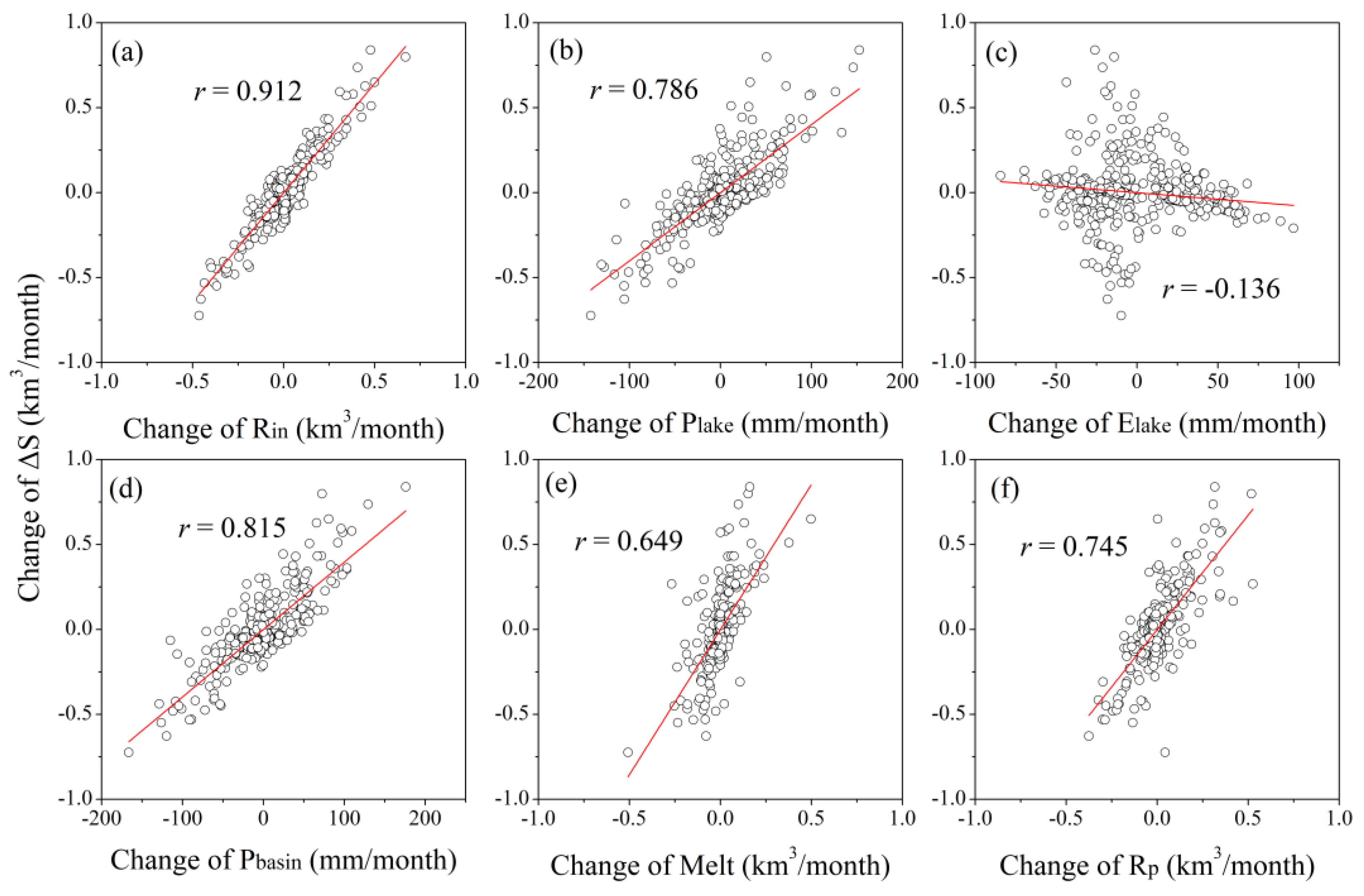
| Year | Duration * | Transition Date | Year | Duration * | Transition Date |
|---|---|---|---|---|---|
| 1980–2000 | 11 Nov.–18 May (185 days) | 13 Mar. | 2009 | 5 Nov.–5 May (181 days) | 12 Mar. |
| 2001 | 11 Nov.–6 May (176 days) | 8 Mar. | 2010 | 11 Nov.–21 May (191 days) | 10 Mar. |
| 2002 | 6 Nov.–28 May (203 days) | 9 Mar. | 2011 | 17 Nov.–10 May (174 days) | 12 Mar. |
| 2003 | 9 Nov.–23 May (195 days) | 1 Mar. | 2012 | 16 Nov.–25 May (191 days) | 22 Mar. |
| 2004 | 13 Nov.–19 May (188 days) | 26 Mar. | 2013 | 14 Nov.–19 May (186 days) | 28 Feb. |
| 2005 | 6.Nov.–26 May (201 days) | 19 Mar. | 2014 | 6 Nov.–23 May (198 days) | 20 Apr. |
| 2006 | 8 Nov.–21 May (194 days) | 24 Feb. | 2015 | 19 Nov.–17 May (179 days) | 28 Mar. |
| 2007 | 17 Nov.–17 May (181 days) | 21 Mar. | 2016 | 4 Nov.–12 May (190 days) | 25 Mar. |
| 2008 | 12 Nov.–10 May (180 days) | 5 Mar. | 2016–2017 | 16 Nov.–18 May (183 days) | — |
| Period | Precipitation Runoff | Melt | Lake Surface Precipitation | Lake Surface Evaporation |
|---|---|---|---|---|
| 1980–1987 | 76% | 20% | 29% | −25% |
| 1988–2008 | 70% | 31% | 25% | −26% |
| 2009–2016 | 84% | 33% | 31% | −49% |
| Value (mm) | Period | Methods | Source |
|---|---|---|---|
| 1149 ± 71 | 1980–2016 | Penman formula | This study |
| 981 ± 18 | Unfrozen period of 2016 | EC methods | Wang et al., 2019 [67] |
| 693 | 1961–2015 | FR estimation | Li et al., 2017 [30] |
| 832 ± 69 | 1980–2014 | Flake model | Lazhu et al., 2016 [66] |
| 635 | 1979–2012 | CRLE | Ma et al., 2016 [38] |
| About 650 | 1980–2010 | MWB model | Wu et al., 2014 [29] |
| About 600 | May to Oct. of 2007–2011 | Observations | Zhou et al., 2013 [20] |
| 1184 | 1976–2009 | Penman formula | Zhang et al., 2011 [17] |
| 1430 | 1971–2004 | Penman formula | Zhu et al., 2010 [18] |
| Period | Runoff | Melt | Precipitation | Air Temperature |
|---|---|---|---|---|
| 1980–1988 | 2.69 m3 s−1/10a | 11.16 m3 s−1/10a | 20.85 mm/10a | 1.46 K/10a * |
| 1988–2009 | 4.29 m3 s−1/10a * | 5.34 m3 s−1/10a | 39.87 mm/10a | 0.38 K/10a * |
| 2009–2016 | −5.89 m3 s−1/10a | −4.63 m3 s−1/10a | −44.95 mm/10a | 1.35 K/10a |
© 2020 by the authors. Licensee MDPI, Basel, Switzerland. This article is an open access article distributed under the terms and conditions of the Creative Commons Attribution (CC BY) license (http://creativecommons.org/licenses/by/4.0/).
Share and Cite
Zhong, X.; Wang, L.; Zhou, J.; Li, X.; Qi, J.; Song, L.; Wang, Y. Precipitation Dominates Long-Term Water Storage Changes in Nam Co Lake (Tibetan Plateau) Accompanied by Intensified Cryosphere Melts Revealed by a Basin-Wide Hydrological Modelling. Remote Sens. 2020, 12, 1926. https://doi.org/10.3390/rs12121926
Zhong X, Wang L, Zhou J, Li X, Qi J, Song L, Wang Y. Precipitation Dominates Long-Term Water Storage Changes in Nam Co Lake (Tibetan Plateau) Accompanied by Intensified Cryosphere Melts Revealed by a Basin-Wide Hydrological Modelling. Remote Sensing. 2020; 12(12):1926. https://doi.org/10.3390/rs12121926
Chicago/Turabian StyleZhong, Xiaoyang, Lei Wang, Jing Zhou, Xiuping Li, Jia Qi, Lei Song, and Yuanwei Wang. 2020. "Precipitation Dominates Long-Term Water Storage Changes in Nam Co Lake (Tibetan Plateau) Accompanied by Intensified Cryosphere Melts Revealed by a Basin-Wide Hydrological Modelling" Remote Sensing 12, no. 12: 1926. https://doi.org/10.3390/rs12121926
APA StyleZhong, X., Wang, L., Zhou, J., Li, X., Qi, J., Song, L., & Wang, Y. (2020). Precipitation Dominates Long-Term Water Storage Changes in Nam Co Lake (Tibetan Plateau) Accompanied by Intensified Cryosphere Melts Revealed by a Basin-Wide Hydrological Modelling. Remote Sensing, 12(12), 1926. https://doi.org/10.3390/rs12121926





